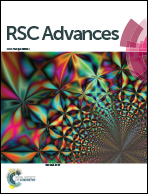Hierarchically nanostructured MnO2 electrodes for pseudocapacitor application†
Abstract
The supercapacitive properties of hierarchically nanostructured manganese oxide (MnO2) electrodes were investigated. The hierarchical MnO2 nanostructures consisting of nanowires in a small length scale and inverse-opal nanostructures in a large length scale were successfully fabricated using a combination of colloidal nanosphere lithography and cyclic voltammetric deposition. A maximum specific capacitance, Csp, of 714 F g−1 at the scan rate of 10 mV s−1 was obtained, which was significantly larger than 556 F g−1 observed for the MnO2 electrode with simple nanowire structures. The enhancement of the Csp value is attributed to the lower charge-transfer and diffusive resistance of the hierarchical nanostructures, which was estimated by electrochemical impedance measurements. The other capacitive properties were also improved considerably. The Csp retention for the hierarchical nanostructure electrode after 5000 charge–discharge cycles was 75.4%, and the voltammetric response at high scan rates was 1.8 times larger than that for the simple nanowire electrode.


 Please wait while we load your content...
Please wait while we load your content...